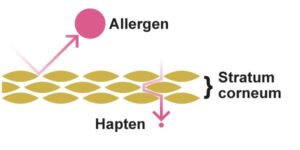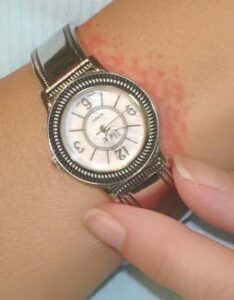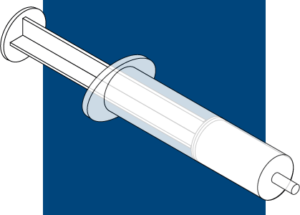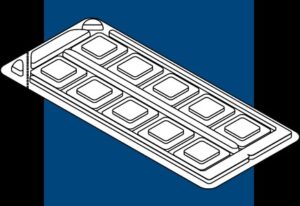Contact Allergy

Contact Allergy = Immune responses caused by antigens in skin.
Hapten + Protein in skin = Antigen
Examples of haptens: nickel, formaldehyde and preservatives in cosmetics Allergens ≠ Haptens

Contact Allergy is the state of being sensitized to a hapten. Sensitization = when exposure to hapten surpasses a certain threshold Threshold is individual
Prevalence of Contact Allergy = 20% of general population
Chronic once developed, and with no known cure, contact allergy can be of major distress for those affected.
Allergic Contact Dermatitis

Allergic Contact Dermatitis (ACD), a disease of the skin (skin inflammation (redness, flaking skin or blisters) in individuals with Contact Allergy after exposure to hapten.
Allergic Contact Dermatitis ≠ Irritant Contact Dermatitis
Occupational exposure to haptens = high risk of developing CA and ACD At risk occupations (not limited to):
- hairdressing
- construction work
- cleaning and
- health care

ACD from nickel caused by wrist watch and earrings


ACD from chromium (as part of cement) on hands of construction worker
Diagnosis

Contact Allergy: diagnosed with Patch Testing
Patch Test ≠ Skin Allergy Test (Prick Test)
The patch test procedure is an epicutaneous diagnostic provocation test using standardized haptens able to elicit an immune response. Patch testing is performed by applying haptens into small chambers mounted on tape and placed onto the patient’s skin. In sensitized individuals this immune response results in an allergic contact dermatitis (eczema) confined to the application area of the chamber on the patient’s skin.
When to consider Patch Testing?
When should Patch Testing be considered?

The indication for Patch Testing is to test all patients in whom contact allergy is suspected or needs to be ruled out, regardless of age or anatomical site of dermatitis.
When should Patch Testing be considered?
For instance:
- When a patient shows signs of Contact Allergy, for instance has suspected contact dermatitis or skin and mucous eruptions
- When a patient suffers from other types of (chronic) dermatitis (eczema) not improving with treatment
- It may also may be considered as a preemptive measure before surgery

Contraindications:
- Do not apply hapten on patients undergoing cortisone treatment or taking other medication altering the immune system such as immunosuppressive
- Do not apply hapten on a patient with a known history of severe allergic reaction (local or systemic) to the hapten in question or on patients with excited skin
- Do not apply hapten on unhealthy or injured skin, skin with active dermatitis or on a test area recently exposed to ultraviolet radiation (UV).
- Pregnancy and lactation may be a conditional contraindication as there are no data on the safety of the test for the mother and
Patch Test Materials

Chemotechnique provides all tools required to perform patch tests – the gold standard for diagnosing contact allergy.
In order to perform a diagnostic Patch Test, two crucial components are required; Patch Test Haptens and Patch Test Units.
Patch Test Haptens – The Patch Test Haptens manufactured by Chemotechnique are standardized and prepared by mixing high purity fine particle ground raw material, with high purity grade white petrolatum using state of the art technology.
Haptens are arranged in sets of Series:
A Baseline Series forms the foundation of each patch test and consists of the haptens with the overall highest relevance in a specific region.
Depending on patient history and occupational exposure, additional Screening Series (such as the Hairdressing or Cosmetics Series) are tested alongside the Baseline Series.
Baseline Series
International Baseline Series
International Comprehensive Baseline
Regional Baseline Series
European Baseline Australian Baseline Belgiam Baseline British Baseline Chinese Baseline Finnish Baseline Hungarian Baseline
Indian Baseline Korean Baseline Latin American Baseline North American Baseline North American Extended
North American Comprehensive Polish Baseline Portuguese Baseline Spanish Baseline Swedish Baseline
Screening Series
Bakery Series
Corticosteroid Series
Cosmetic Series
Cutaneous Adverse Drug Reaction Series
Dental Screening Series
Dental Materials Patients
Dental Materials Staff Epoxy Series
European Photopatch Baseline Series
European Photopatch Extended Series
Fragrance Series
Hairdressing Series
International Standard Series
Isocyanate Series
Leg Ulcer Series
Medicament Series
Metal Series
(Meth) Acrylate Series – Adhesives, Dental & Other
(Meth) Acrylate Series – Nails-Artificial
(Meth) Acrylate Series – Printing North American Photopatch
Oil & Cooling Fluid Series
Photographic Chemicals Series
Plant Series
Plastics & Glues Series
Rubber Additives Series
Shoe Series
Sunscreen Series
Textile Colours & Finish Various Haptens
Patch Test Material

Patch Test Units – To ensure that the hapten remains in direct contact with the skin for the time required to create a standardized controlled reaction (48h), a Patch Test Unit is needed.
A Patch Test Unit is composed of 10 chambers mounted on an adhesive tape. The chambers provide a defined area in which the skin will be exposed to the haptens during the testing.
Due to the nature of patch testing it is important that the Patch Test Units used have good occlusion to the skin and that they are made of inert materials that do not interfere with the haptens tested or elicit an allergic reaction in sensitized patients.
Chemotechnique produces two widely acknowledged Patch Test Units: The IQ Ultra™ and the IQ Ultimate™

IQ Ultra™ is a reliable Patch Test Units designed to make full advantage of the acclaimed IQ Chambers.
IQ Chambers
- Leak-free
- Integrated filter paper for liquid haptens
- Square shape facilitates differentiating allergic from irritant reactions
- Inert and Aluminum free


Preloadable
Preloading helps maximize staff efficiency as multiple tests can be prepared in advance.
By using the Application Device, loading of the test units is made efficient and time saving.
IQ Ultimate™ is the elastic, transparent and water resistant Patch Test Unit with the advanced
IQ Chamber technology:

- Water Resistant
Withstands showers and perspiration
- Highly elastic
Ideal for active patients and children
- Superior adhesion









